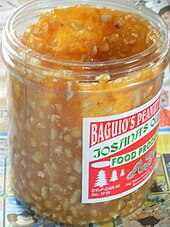Brittle
Brittle (from the 19th century French croquant , "crispy bakery" borrowed) is a mixture of chopped nuts , usually almonds , hazelnuts or walnuts and caramelized sugar . It can also contain butter or other fats. It is also possible to add milk powder , cream powder , glucose syrup , honey and dried fruit .
Brittle is used as an ingredient or decoration for desserts , ice cream and baked goods (e.g. Florentines and cakes such as Frankfurter Kranz ). Bite-sized pieces of brittle butter are served as confectionery . Depending on its consistency, a distinction is made between the three types of brittle , hard brittle , soft brittle and leaf or crumbly brittle .
Manufacturing
To make it, sugar is first brought to caramelize in a pan . Then the chopped or finely cut nuts are added while stirring. The nuts are roasted and give the brittle its typical taste. The mass is poured onto an oiled plate, pressed apart with an oiled rolling pin and, after cooling, more or less finely crumbled or crushed depending on the intended use.
Hard brittle and soft brittle
The consistency of brittle is determined by the amount of plasticizing additives (e.g. honey, glucose syrup): hard brittle contains less of these substances than soft brittle. For soft brittle z. B. fat or marzipan incorporated, the brittle gets a soft, pasty texture.
Crumbly brittle and leaf brittle
Shortcrust brittle contains a portion of nougat mass, which makes it soft and supple. If the shortcrust brittle with a filling of nougat mass, persipan, marzipan or other raw masses is beaten and rolled out several times, layers similar to puff pastry form , the so-called brittle leaves. During manufacture, several layers of nut and almond paste are placed between layers of melted sugar.
In Switzerland , brittle leaves are also known as nougat.
Industrial manufacture
In industrial production, brittle is defined as a mixture of caramelized sugar and / or glucose with seeds. The proportion of seeds is at least 20%. The sugar is melted and caramelized in large stirring kettles with constant movement, the temperature is over 190 ° C. The other ingredients are added at different points; it is advantageous to set up several temperature zones. The mass is then cooled and given for further processing. The seed kernels must, as far as technically possible, be freed from the seed skin. Almonds or nuts are used, such as B. Walnuts. The seed kernels are traded according to the guiding principles for oil seeds, accordingly other seed kernels used must be declared (for example peanut or coconut brittle).
Web links
Individual evidence
- ↑ a b c d e G. Gotsch: confectionery technology . In: Dieter Osteroth (Hrsg.): Pocket book for food chemists and technologists . tape 2 . Springer-Verlag , Berlin / Heidelberg 1991, ISBN 978-3-642-63506-9 , p. 260-261 , doi : 10.1007 / 978-3-642-58220-2_19 .
- ↑ a b M. Claus: Sugar goods . In: Rudolf Heiss (ed.): Food technology . 6th edition. Springer, Berlin / Heidelberg 2004, ISBN 978-3-642-62447-6 , pp. 335 , doi : 10.1007 / 978-3-642-55577-0_31 .
- ↑ Hoffmann, Hartmut., Mauch, Werner., Untze, Werner .: Sugar and sugar products . 2nd edition, 2nd reprint. Behr's Verlag, Hamburg 2010, ISBN 3-86022-937-0 , p. 181-183 .
- ^ A b Adolf Krell: Commodity food . In: Textbooks and specialist books for vocational training . Fachbuchverlag, 1961, p. 332 .
- ↑ Hartmut Hoffmann, Werner Mauch, Werner Untze: Sugar and sugar products . Behr's Verlag DE, 2002, ISBN 978-3-86022-937-8 , pp. 182 ( google.de [accessed on July 25, 2019]).

